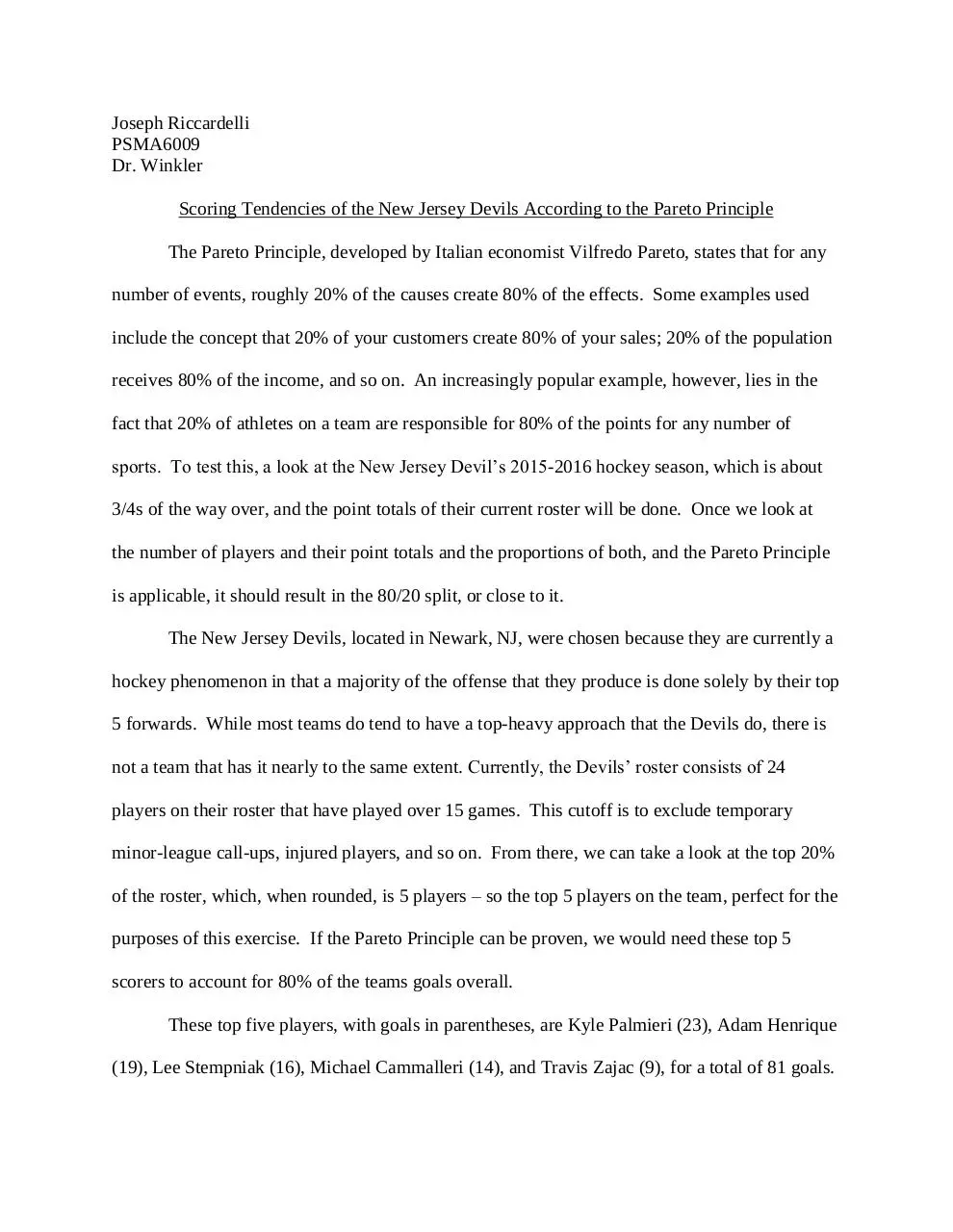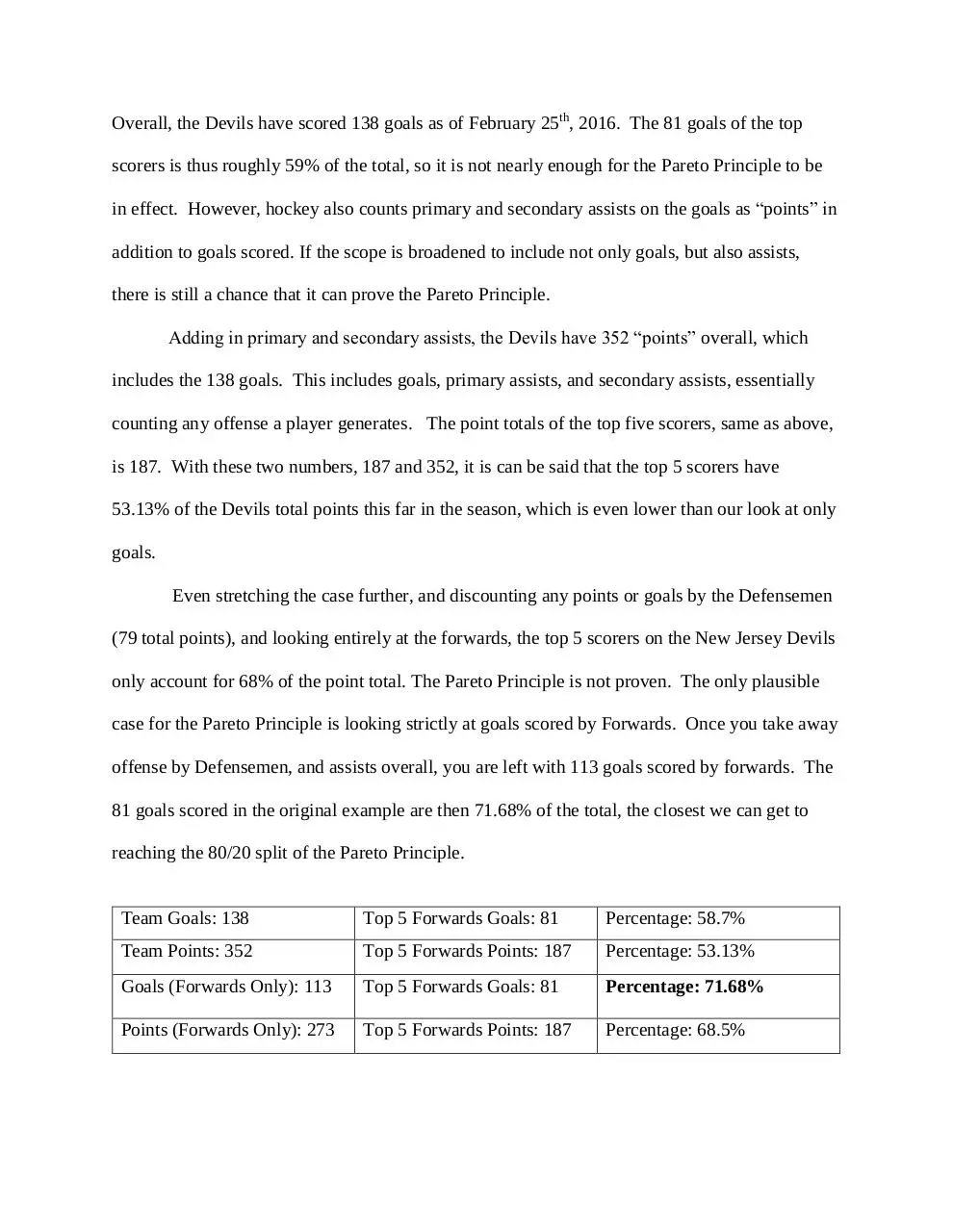Joseph Riccardelli 1 (PDF)
File information
Author: Joseph A Riccardelli
This PDF 1.5 document has been generated by Microsoft® Word 2013, and has been sent on pdf-archive.com on 25/02/2016 at 20:35, from IP address 149.150.x.x.
The current document download page has been viewed 500 times.
File size: 117.23 KB (2 pages).
Privacy: public file


File preview
Joseph Riccardelli
PSMA6009
Dr. Winkler
Scoring Tendencies of the New Jersey Devils According to the Pareto Principle
The Pareto Principle, developed by Italian economist Vilfredo Pareto, states that for any
number of events, roughly 20% of the causes create 80% of the effects. Some examples used
include the concept that 20% of your customers create 80% of your sales; 20% of the population
receives 80% of the income, and so on. An increasingly popular example, however, lies in the
fact that 20% of athletes on a team are responsible for 80% of the points for any number of
sports. To test this, a look at the New Jersey Devil’s 2015-2016 hockey season, which is about
3/4s of the way over, and the point totals of their current roster will be done. Once we look at
the number of players and their point totals and the proportions of both, and the Pareto Principle
is applicable, it should result in the 80/20 split, or close to it.
The New Jersey Devils, located in Newark, NJ, were chosen because they are currently a
hockey phenomenon in that a majority of the offense that they produce is done solely by their top
5 forwards. While most teams do tend to have a top-heavy approach that the Devils do, there is
not a team that has it nearly to the same extent. Currently, the Devils’ roster consists of 24
players on their roster that have played over 15 games. This cutoff is to exclude temporary
minor-league call-ups, injured players, and so on. From there, we can take a look at the top 20%
of the roster, which, when rounded, is 5 players – so the top 5 players on the team, perfect for the
purposes of this exercise. If the Pareto Principle can be proven, we would need these top 5
scorers to account for 80% of the teams goals overall.
These top five players, with goals in parentheses, are Kyle Palmieri (23), Adam Henrique
(19), Lee Stempniak (16), Michael Cammalleri (14), and Travis Zajac (9), for a total of 81 goals.
Overall, the Devils have scored 138 goals as of February 25th, 2016. The 81 goals of the top
scorers is thus roughly 59% of the total, so it is not nearly enough for the Pareto Principle to be
in effect. However, hockey also counts primary and secondary assists on the goals as “points” in
addition to goals scored. If the scope is broadened to include not only goals, but also assists,
there is still a chance that it can prove the Pareto Principle.
Adding in primary and secondary assists, the Devils have 352 “points” overall, which
includes the 138 goals. This includes goals, primary assists, and secondary assists, essentially
counting any offense a player generates. The point totals of the top five scorers, same as above,
is 187. With these two numbers, 187 and 352, it is can be said that the top 5 scorers have
53.13% of the Devils total points this far in the season, which is even lower than our look at only
goals.
Even stretching the case further, and discounting any points or goals by the Defensemen
(79 total points), and looking entirely at the forwards, the top 5 scorers on the New Jersey Devils
only account for 68% of the point total. The Pareto Principle is not proven. The only plausible
case for the Pareto Principle is looking strictly at goals scored by Forwards. Once you take away
offense by Defensemen, and assists overall, you are left with 113 goals scored by forwards. The
81 goals scored in the original example are then 71.68% of the total, the closest we can get to
reaching the 80/20 split of the Pareto Principle.
Team Goals: 138
Top 5 Forwards Goals: 81
Percentage: 58.7%
Team Points: 352
Top 5 Forwards Points: 187
Percentage: 53.13%
Goals (Forwards Only): 113
Top 5 Forwards Goals: 81
Percentage: 71.68%
Points (Forwards Only): 273
Top 5 Forwards Points: 187
Percentage: 68.5%
Download Joseph Riccardelli-1
Joseph Riccardelli-1.pdf (PDF, 117.23 KB)
Download PDF
Share this file on social networks
Link to this page
Permanent link
Use the permanent link to the download page to share your document on Facebook, Twitter, LinkedIn, or directly with a contact by e-Mail, Messenger, Whatsapp, Line..
Short link
Use the short link to share your document on Twitter or by text message (SMS)
HTML Code
Copy the following HTML code to share your document on a Website or Blog
QR Code to this page

This file has been shared publicly by a user of PDF Archive.
Document ID: 0000343399.